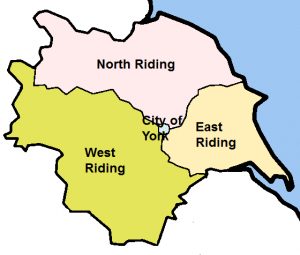Difference between revisions of "Yorkshire"
From LGBT Archive
Ross Burgess (Talk | contribs) |
(→LGBT history: book by Helen Smith) |
||
| (One intermediate revision by one other user not shown) | |||
| Line 1: | Line 1: | ||
[[File:YorkshireRidingsLabelled.png|thumb|Historic divisions of Yorkshire: the three Ridings and the City of York]][[File:YorkshireCounties.png|thumb|Current ceremonial counties of Yorkshire]]'''Yorkshire''' is historically the largest county in England. Because of its size it was divided into the [[East Riding]], [[West Riding]], and [[North Riding]], each of which had its own county council from 1889. It is now part of the [[Yorkshire and the Humber]] region. | [[File:YorkshireRidingsLabelled.png|thumb|Historic divisions of Yorkshire: the three Ridings and the City of York]][[File:YorkshireCounties.png|thumb|Current ceremonial counties of Yorkshire]]'''Yorkshire''' is historically the largest county in England. Because of its size it was divided into the [[East Riding]], [[West Riding]], and [[North Riding]], each of which had its own county council from 1889. It is now part of the [[Yorkshire and the Humber]] region. | ||
| − | In 1974 and again in 1996 the local government areas were reorganised, and Yorkshire is now divided into: | + | In 1974 and again in 1996 the local government areas were reorganised, and Yorkshire is now divided into four ceremonial counties: |
*[[West Yorkshire]] ([[metropolitan county]], comprising five boroughs) | *[[West Yorkshire]] ([[metropolitan county]], comprising five boroughs) | ||
*[[South Yorkshire]] ([[metropolitan county]], comprising four boroughs) | *[[South Yorkshire]] ([[metropolitan county]], comprising four boroughs) | ||
| Line 7: | Line 7: | ||
*[[East Riding of Yorkshire]] ( comprising two [[unitary authorities]], the [[East Riding of Yorkshire]] itself and the city of [[Hull]]). | *[[East Riding of Yorkshire]] ( comprising two [[unitary authorities]], the [[East Riding of Yorkshire]] itself and the city of [[Hull]]). | ||
| − | Between 1974 and 1976 | + | Between 1974 and 1976 the current East Riding (including Hull) was joined with part of [[Lincolnshire]] to comprise the county of [[Humberside]]. |
==LGBT history== | ==LGBT history== | ||
| Line 14: | Line 14: | ||
[[Yorkshire Terriers FC]] is a gay and lesbian football club based in [[Leeds]]. | [[Yorkshire Terriers FC]] is a gay and lesbian football club based in [[Leeds]]. | ||
| + | |||
| + | Helen Smith's book 'Masculinity, Class and Same-Sex Desire in Industrial England, 1895-1957' (2015) is largely about Yorkshire. | ||
[[Category:Yorkshire| ]] | [[Category:Yorkshire| ]] | ||
[[Category:English regions]] | [[Category:English regions]] | ||
Latest revision as of 18:32, 1 June 2019
Yorkshire is historically the largest county in England. Because of its size it was divided into the East Riding, West Riding, and North Riding, each of which had its own county council from 1889. It is now part of the Yorkshire and the Humber region.In 1974 and again in 1996 the local government areas were reorganised, and Yorkshire is now divided into four ceremonial counties:
- West Yorkshire (metropolitan county, comprising five boroughs)
- South Yorkshire (metropolitan county, comprising four boroughs)
- North Yorkshire (comprising seven districts, plus four unitary authorities including the City of York)
- East Riding of Yorkshire ( comprising two unitary authorities, the East Riding of Yorkshire itself and the city of Hull).
Between 1974 and 1976 the current East Riding (including Hull) was joined with part of Lincolnshire to comprise the county of Humberside.
LGBT history
Anne Lister lived in Yorkshire in the early 19th century.
Yorkshire Terriers FC is a gay and lesbian football club based in Leeds.
Helen Smith's book 'Masculinity, Class and Same-Sex Desire in Industrial England, 1895-1957' (2015) is largely about Yorkshire.

